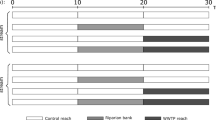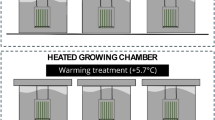Abstract
The ability of asexual propagules to disperse is an important ecological determinant of the spread and establishment of many aquatic species. However, few previous studies have addressed the relationship between the asexual propagule buoyancy and sprouting abilities in submerged macrophytes. For this reason, turions of Potamogeton crispus samples were collected from Lake Liangzi, and an incubator sprouting experiment was conducted. Our results revealed that the floating turions showed higher sprouting rates than that of sinking turions, indicating the former ones are possibly with high levels of primary metabolites. The higher N and P concentrations in the floating turions caused lower C:N, C:P, and N:P ratios in these turions compared with sinking turions, which confirmed the activation of floating turions. The free amino acid and soluble carbohydrate concentrations were also higher in floating turions than those in sinking turions. Our results also revealed that turion leaf porosity rather than starch concentration may determine the density of P. crispus turions. This study makes a contribution to our understanding of how the internal characteristics of turions can (at least partly) determine dispersal outcomes and offers new insights into the dispersal and sprouting of asexual propagules of submerged macrophytes.


Similar content being viewed by others
References
Adamec, L., 1999. Turion overwintering of aquatic carnivorous plants. Carnivorous Plant Newsletter 28: 19–24.
Adamec, L., 2003. Ecophysiological characterization of dormancy states in turions of the aquatic carnivorous plant Aldrovanda vesiculosa. Biologia Plantarum 47: 395–402.
Adamec, L., 2008. Respiration of turions and winter apices in aquatic carnivorous plants. Biologia 63: 515–520.
Adamec, L., 2010. Tissue mineral nutrient content in turions of aquatic plants: does it represent a storage function? Fundamental and Applied Limnology 176: 145–151.
Adamec, L., 2011. Dark respiration and photosynthesis of dormant and sprouting turions of aquatic plants. Fundamental and Applied Limnology 179: 151–158.
Appenroth, K. J. & H. Gabrys, 2001. Light-induced starch degradation in non-dormant turions of Spirodela polyrhiza. Photochemistry and Photobiology 73: 77–82.
Appenroth, K. J. & P. Ziegler, 2008. Light-induced degradation of storage starch in turions of Spirodela polyrhiza depends on nitrate. Plant, Cell & Environment 31: 1460–1469.
Appenroth, K. J., H. Augsten & H. Mohr, 1992. Photophysiology of turion germination in Spirodela polyrhiza (L.) Schleiden. X. Role of nitrate in the phytochrome-mediated response. Plant, Cell & Environment 15: 743–748.
Appenroth, K. J., A. Keresztes, E. Krzysztofowicz & H. Gabrys, 2011. Light-induced degradation of starch granules in turions of Spirodela polyrhiza studied by electron microscopy. Plant & Cell Physiology 52: 384–391.
Barko, J. W. & R. M. Smart, 1981. Comparative influences of light and temperature on the growth and metabolism of selected submersed freshwater macrophytes. Ecological Monographs 51: 219–236.
Boedeltje, G., J. P. Bakker, R. M. Bekker, J. M. Van Groenendael & M. Soesbergen, 2003. Plant dispersal in a lowland stream in relation to occurrence and three specific life-history traits of the species in the species pool. Journal of Ecology 91: 855–866.
Bolduan, B. R., G. C. van Eeckhout, H. W. Quade & J. E. Gannon, 1994. Potamogeton crispus—the other invader. Lake and Reservoir Management 10: 113–125.
Bray, R. H. & L. T. Kurz, 1945. Determination of total organic and available forms of phosphorus in soils. Soil Science 59: 39–45.
Cao, T., L. Ni, P. Xie, J. Xu & M. Zhang, 2011. Effects of moderate ammonium enrichment on three submersed macrophytes under contrasting light availability. Freshwater Biology 56: 1620–1629.
Chambers, P. A., D. H. N. Spence & D. C. Weeks, 1985. Photocontrol of turion formation by Potamogeton crispus L. in the laboratory and natural water. New Phytologist 99: 183–194.
Chambert, S. & C. S. James, 2009. Sorting of seeds by hydrochory. River Research and Applications 25: 48–61.
Deng, Z. M., X. S. Chen, Y. H. Xie, X. Li, Y. Pan & F. Li, 2013. Effects of size and vertical distribution of buds on sprouting and plant growth of the clonal emergent macrophyte Miscanthus sacchariflorus (Poaceae). Aquatic Botany 104: 121–126.
Elser, J. J., D. R. Dobberfuhl, N. A. MacKay & J. H. Schampel, 1996. Organism size, life history, and N:P stoichiometry. Bioscience 46: 674–684.
Elser, J. J., R. W. Sterner, E. Gorokhova, W. F. Fagan, T. A. Markow, J. B. Cotner, J. F. Harrison, S. E. Hobbie, G. M. Odell & L. W. Weider, 2000. Biological stoichiometry from genes to ecosystems. Ecology Letters 3: 540–550.
Hajirezaei, M. R., F. Börnke, M. Peisker, Y. Takahata, J. Lerchl, A. Kirakosyan & U. Sonnewald, 2003. Decreased sucrose content triggers starch breakdown and respiration in stored potato tubers (Solanum tuberosum). Journal of Experimental Botany 54: 477–488.
Harada, T. & I. Kimiharu, 2003. Starch degradation and sucrose metabolism during anaerobic growth of pondweed (Potamogeton distinctus A. Benn.) turions. Plant and Soil 253: 125–135.
James, W. F., J. W. Barko, H. L. Eakin & P. W. Sorge, 2002. Phosphorus budget and management strategies for an urban Wisconsin lake. Lake and Reservoir Management 18: 149–163.
Jian, Y., B. Li, J. Wang & J. Chen, 2003. Control of turion germination in Potamogeton crispus. Aquatic Botany 75: 59–69.
Karunagaran, D. & P. Ramakrishna Rao, 1991. Mode and control of starch mobilization during germination of seed of horse gram. Plant Science 73: 155–159.
Klimešová, J. & L. Klimeš, 2007. Bud banks and their role in vegetative regeneration—a literature review and proposal for simple classification and assessment. Perspectives in Plant Ecology, Evolution and Systematics 8: 115–129.
Kunii, H., 1989. Continuous growth and clump maintenance of Potamogeton crispus L. in Narutoh river, Japan. Aquatic Botany 33: 13–26.
Ley, S., K. Dölger & K. J. Appenroth, 1997. Carbohydrate metabolism as a possible physiological modulator of dormancy in turions of Spirodela polyrhiza (L.) Schleiden. Plant Science 129: 1–7.
Morris, D., 1948. Quantitative determination of carbohydrates with Dreywood’s anthrone reagent. Science 107: 254–255.
Okada, M., B. J. Grewell & M. Jasieniuk, 2009. Clonal spread of invasive Ludwigia hexapetala and L. grandiflora in freshwater wetlands of California. Aquatic Botany 91: 123–129.
Quade, H. W., G. C. van Eeckhout, B. R. Bolduan, J. E. Gannon, C. J. Olson & C. B. Sathrum, 1994. Duck lake diagnostic report, Cleanwater Partnership Phase I. Minnesota Pollution Control Agency, St. Paul, MN.
Riis, T. & K. Sand-Jensen, 2006. Dispersal of plant fragments in small streams. Freshwater Biology 51: 274–286.
Rivas-Ubach, A., J. Sardans, M. Pérez-Trujillo, M. Estiarte & J. Peñuelas, 2012. Strong relationship between elemental stoichiometry and metabolome in plants. Proceedings of the National Academy of Sciences 109: 4181–4186.
Rogers, K. H. & C. M. Breen, 1980. Growth and reproduction of Potamogeton crispus in a South African lake. Journal of Ecology 68: 561–571.
Santamaría, L., 2002. Why are most aquatic plants widely distributed? Dispersal, clonal growth and small-scale heterogeneity in a stressful environment. Acta Oecologica 23: 137–154.
Sarneel, J. M., 2012. The dispersal capacity of vegetative propagules of riparian fen species. Hydrobiologia 710: 219–225.
Sastroutomo, S. S., 1981. Turions formation, dormancy and germination of curly pondweed, Potamogeton crispus L. Aquatic Botany 10: 161–173.
Sastroutomo, S. S., I. Ikusima, M. Numata & S. Iizumi, 1979. The importance of turions in the propagation of pondweed (Potamogeton crispus L.). Ecological Review 19: 75–88.
Sculthorpe, C. D., 1967. The Biology of Aquatic Vascular Plants. Edward Arnold, London.
Spencer, D. F., F. J. Ryan, L. Aung & G. G. Ksander, 2001. Soluble sugar concentrations associated with tuber and winter bud sprouting. Journal of Aquatic Plant Management 39: 45–47.
Suzuki, J. I. & J. F. Stuefer, 1999. On the ecological and evolutionary significance of storage in clonal plants. Plant Species Biology 14: 11–17.
van den Broek, T., R. van Diggelen & R. Bobbink, 2005. Variation in seed buoyancy of species in wetland ecosystems with different flooding dynamics. Journal of Vegetation Science 16: 579–586.
Venable, D. L. & L. Lawlor, 1980. Delayed germination and dispersal in desert annuals: escape in space and time. Oecologia 46: 272–282.
Weber, J. A. & L. D. Noodén, 2005. The causes of sinking and floating in turions of Myriophyllum verticillatum. Aquatic Botany 83: 219–226.
Wehrmeister, B. S., 1978. An ecological life history of the pondweed Potamogeton crispus L. in North America. Ohio State University, Columbus: 157.
Winston, R. D. & P. R. Gorham, 1979. Turions and dormancy states in Utricularia vulgaris. Canadian Journal of Botany 57: 2740–2749.
Witty, M., 2009. Wolffia columbiana can switch between two anatomically and physiologically separate states: buoyant for invasion and starch rich for colonization. International Journal of Botany 5: 307–313.
Woolf, T. E. & J. D. Madsen, 2003. Seasonal biomass and carbohydrate allocation patterns in Southern Minnesota curlyleaf pondweed populations. Journal of Aquatic Plant Management 41: 113–118.
Wu, J., S. Cheng, W. Liang, F. He & Z. Wu, 2009. Effects of sediment anoxia and light on turion germination and early growth of Potamogeton crispus. Hydrobiologia 628: 111–119.
Xie, D. & D. Yu, 2011. Turion production and nutrient reserves in Potamogeton crispus are influenced by sediment nutrient level. Aquatic Biology 14: 21–28.
Xie, Y., D. Yu & X. Geng, 2003. Effects of elevated CO2 concentration on phenotypic, physiological and biochemical characteristics of submersed plant Potamogeton crispus leaf. Acta Phytoecologia Sinica 27: 218–222.
Yemm, E. W. & E. C. Cocking, 1955. The determination of amino acids with ninhydrin. Analyst 80: 209–213.
Zhang, Y. Y., D. Y. Zhang & S. C. H. Barrett, 2010. Genetic uniformity characterizes the invasive spread of water hyacinth (Eichhornia crassipes), a clonal aquatic plant. Molecular Ecology 19: 1774–1786.
Acknowledgments
We thank Dr. Ling-fei Yu, Hui Wang, Shu-feng Fan, and Jin-ning Zhu for laboratory/field assistance and helpful discussions. This research was supported by the National Natural Science Foundation of China (31370382 and 30930011).
Author information
Authors and Affiliations
Corresponding author
Additional information
Handling editor: Sidinei Magela Thomaz
Rights and permissions
About this article
Cite this article
Xie, D., Yu, D., Xia, C. et al. Stay dormant or escape sprouting? Turion buoyancy and sprouting abilities of the submerged macrophyte Potamogeton crispus L.. Hydrobiologia 726, 43–51 (2014). https://doi.org/10.1007/s10750-013-1749-5
Received:
Revised:
Accepted:
Published:
Issue Date:
DOI: https://doi.org/10.1007/s10750-013-1749-5




